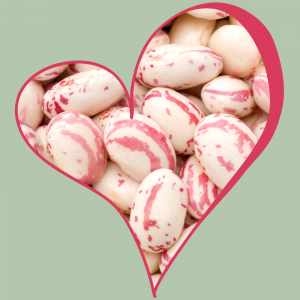 Beans, beans, they’re good for your heart, the more you eat, the more you… Well, you know the rhyme. Their flatulent effect is the stuff of legend. But not many folks are as aware of how heart-healthy beans are. So I thought it high time to write a post on the benefits of beans for cardiovascular health. And anyone who knows me knows why this is a topic near and dear to my heart.
Beans, beans, they’re good for your heart, the more you eat, the more you… Well, you know the rhyme. Their flatulent effect is the stuff of legend. But not many folks are as aware of how heart-healthy beans are. So I thought it high time to write a post on the benefits of beans for cardiovascular health. And anyone who knows me knows why this is a topic near and dear to my heart.
With the recent demonization of carbohydrates and great swathes of the populace adopting the ketogenic diet, it seems we may be forgetting that carbs are not all created equal. Yes, sugar, white rice, white flour, processed baked goods and their ilk should definitely be only occasional indulgences. But as I said in the post for my Winter Warm Up Menu, vegetables and fruits are carbs as well, and these are about the only foods undisputed by experts to be absolutely healthy for you.
So drastically reducing all carbs is akin to throwing the proverbial baby out with the bathwater. I think the healthiest diet is a prudent, personalized mix of healthy carbs, protein and fats. Think of them as three legs of a stool – without one leg, there is no balance. And beans are undeniably in the healthy carb camp.
Surprisingly, when I advise my clients to add even a modicum of beans to their diet, I get more push-back than when I ask them to forgo their beloved crusty white baguettes. Pretty much everyone complains about flatulence. But here’s the thing. As well as providing heart-healthy antioxidant power and fibre, the nutrient profile of beans is chock-full of energy promoting B-vitamins. So beans really do help put the wind in your sails! As for that other wind, there is a lot we can do about that, so I invite you to read on.
The B(P) list
When I say beans, what do I mean exactly? I am generally talking about pulses, which are the dried and edible seeds of certain plants from the legume family. Here are some of my favourites:
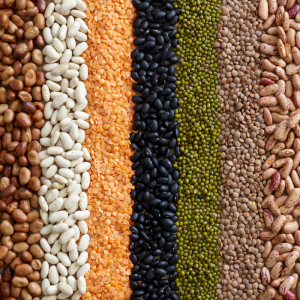 chickpeas/garbanzo beans (my Winter Warm Up Menu includes a delicious Moroccan Chicken & Chickpea Stew)
chickpeas/garbanzo beans (my Winter Warm Up Menu includes a delicious Moroccan Chicken & Chickpea Stew)- lentils (yellow, red, green, brown, French/Puy, black/beluga)
- dried peas/split peas (check out the easy-peasy Cozy Slow Cooker Split Pea & Kale Soup from my Winter Warm Up Menu)
- navy beans
- kidney beans (white and red)
- black beans
- pinto beans
- cranberry beans/borlotti beans (these very pretty beans are in the top photo – sadly, they turn light brown when cooked)
- mung beans
Taking your pulse(s) for a healthy heart
 It’s rather serendipitous that these are called pulses, given how heart-healthy they are. One European study in 2006 concluded that eating four or more (half-cup) servings of legumes a week could reduce your risk of heart disease by 22%. Why is that?
It’s rather serendipitous that these are called pulses, given how heart-healthy they are. One European study in 2006 concluded that eating four or more (half-cup) servings of legumes a week could reduce your risk of heart disease by 22%. Why is that?
Atherosclerosis, which is responsible for coronary artery disease, refers to the hardening of arteries as a result of a buildup of cholesterol-containing plaques. These plaques are the body’s response to damage to the lining of the arteries. Think of a wall in your home. If something damages or dents it, you bring out the plaster to repair it. But the wall gets damaged again and you plaster it over again. And so on.
If you do this often enough, the wall will become thicker and thicker at the site of your repairs. This is what is happening in the arteries. And as the lining becomes thicker and thicker, the diameter of the arteries becomes smaller. As a result, blood pressure increases and your heart needs to work harder to move blood throughout your body. If these plaques rupture they can form blockages that may result in heart attacks and strokes.
The best way to keep your heart healthy is to reduce the damage in the first place. And free radicals usually cause the damage that prompts plaques formation. The body itself produces these highly reactive compounds as part of our metabolic processes. But we also introduce many of them from the outside through our exposure to toxins like air pollution, tobacco smoke, pesticides, fried foods and alcohol, for example. The best defense against free radical damage is to limit our exposure to them and to consume foods with antioxidant properties, as antioxidants help “de-fuse”, if you will, the potential for free radicals to cause damage. Think of free radicals as the fire and antioxidants as the bucket of water that puts the fire out.
Antioxidant power
If we allow more free radicals to build up in our bodies than we have antioxidants to quench them, then we have oxidative stress, which is implicated in heart disease (as well as several other diseases, including cancer and Alzheimer’s, to name a few). So eating a diet high in foods that supply antioxidants is a must for good health. What are these wonder-foods? Plant foods of course! Phytonutrients (which means, literally, plant nutrients) have antioxidant properties. This is why it is so important to get lots of colourful fruits and vegetables in your diet each and every day!
So here’s the surprising thing. When the United States Department of Agriculture (USDA) surveyed the phytonutrient content of one hundred of our most common fruits and veggies in 2004, three of the four top-ranked foods were dried legumes! [The other was wild blueberries, in case you are interested]. Of the legumes, dried lentils and black beans are antioxidant standouts, with almost twice the antioxidant activity of red kidney beans and yellow peas, for example. Chickpeas, delicious though they are, are relatively low in antioxidant activity.
Soluble fibre – a triple-threat against heart disease
Beans are also very high in soluble fibre, which has three benefits for heart health:
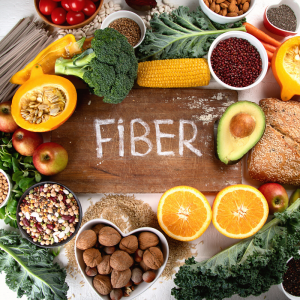 Soluble fibre lowers cholesterol. It appears to do this by binding with bile acids in the gut. Bile acids are high in cholesterol and are used by your body to help digest fat. Soluble fibre helps grab these bile acids in the intestine before they can be reabsorbed by the body and helps transport them out via the feces. So when your body needs to make new bile acids, it will take cholesterol from your blood to do so, thus lowering blood cholesterol.
Soluble fibre lowers cholesterol. It appears to do this by binding with bile acids in the gut. Bile acids are high in cholesterol and are used by your body to help digest fat. Soluble fibre helps grab these bile acids in the intestine before they can be reabsorbed by the body and helps transport them out via the feces. So when your body needs to make new bile acids, it will take cholesterol from your blood to do so, thus lowering blood cholesterol.- Soluble fibre is food for our good gut bacteria. When they feed on this, they produce short-chain fatty acids, which are linked to lower LDL cholesterol levels. And it doesn’t take a hill of beans. This study found that one half-cup of pinto beans per day was as effective at lowering total cholesterol and LDL as a leading prescription drug.
- Fibre keeps blood sugar levels from rising too rapidly. Poorly controlled blood sugar can damage both the blood vessels and the nerves that control your heart and blood vessels. This is why diabetes is a major risk factor for cardiovascular disease. This slow release of sugar into the blood (and the fact that fibre, when taken with water, swells to occupy a lot of space in our stomachs) also keeps our appetites in check, which helps control weight. And a healthy weight is important for a healthy heart.
Given all this, it is no surprise there is strong and consistent evidence that following a Mediterranean Diet, which is rich in beans, is associated with better cardiovascular health, including clinically significant reductions in the rates of coronary heart disease, ischemic stroke, and total cardiovascular disease.
Spilling the beans on phytates and lectins (don’t throw the beans out with the bean-water)
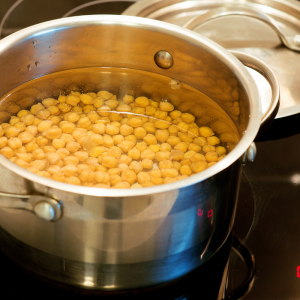 Perhaps you are reluctant to eat beans given what you’ve heard about phytates and lectins. These are “anti-nutrients” found in raw legumes which can interfere with digestion and the absorption of other nutrients. Phytate (also known as phytic acid), for example, can hinder the absorption of minerals such as iron, zinc, magnesium and calcium from the same meal. Lectins are a family of proteins in legumes which resist digestion and may affect the cells lining the gut.
Perhaps you are reluctant to eat beans given what you’ve heard about phytates and lectins. These are “anti-nutrients” found in raw legumes which can interfere with digestion and the absorption of other nutrients. Phytate (also known as phytic acid), for example, can hinder the absorption of minerals such as iron, zinc, magnesium and calcium from the same meal. Lectins are a family of proteins in legumes which resist digestion and may affect the cells lining the gut.
But we usually eat beans that are cooked, not raw. Soaking beans overnight, rinsing and then boiling them in fresh water for as little as ten minutes (and most require longer cooking time) degrades lectins and reduces phytates. Sprouting and fermenting legumes also reduces phytate content. As well, human small intestines produce phytase, an enzyme that breaks down phytic acid, releasing the minerals it binds. And recent studies suggest that our intestines get better over time at absorbing more minerals from phytate-rich foods.
So don’t be scared off by these and throw the beans out with the bean-water. Just throw out the water they were soaked in! Because as well as being packed with heart-healthy antioxidants and soluble fibre, legumes are high in protein and rich in energizing B vitamins, including niacin and folate, and iron.
Cook im-pulse-ively
Pulses are super versatile. So be creative with them and, dare I say, im-pulse-ive! They are wonderful in soups, stews, casseroles, salads and, yes, desserts (spicy black bean brownies…yum)! They also happen to be cheap, particularly if you purchase them dried. And feel free to buy in bulk as they last a very long time.
Most beans are interchangeable in a recipe (although the cooking time may vary when preparing them from dried). When cooking with lentils, yellow or red are best for soups and daal given they become mushy when cooked. Green, brown, French/Puy, black/beluga lentils are best for salads or dishes where you want them to retain their shape. Black lentils (also known as beluga lentils as they look like caviar) are harder to find and more expensive. But they add drama and flair and are the most nutritious of the lentils.
With beans, dinner is literally “in the can”
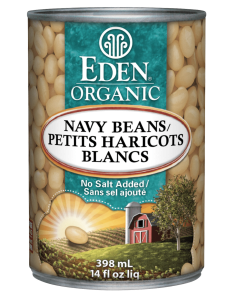 I like using canned beans since they make life easier. And canned beans that you actually eat are better than beans you didn’t because you never got around to soaking and cooking them. Canned beans are the ultimate convenience food! A can opener and a few other pantry staples are all you need to have dinner “in the can”. I purchase organic beans in BPA/BPS-free cans (Eden Organic, pictured at left, is a good brand) and rinse and drain them before using. One of my “go to” meals when I don’t have much time is made from a can of white beans, a can of diced tomatoes, some pre-washed spinach and some crumbled feta. This makes an almost instant meal. Sometimes I toss in some high quality canned tuna and/or black olives and/or fresh basil to make a more gourmet version.
I like using canned beans since they make life easier. And canned beans that you actually eat are better than beans you didn’t because you never got around to soaking and cooking them. Canned beans are the ultimate convenience food! A can opener and a few other pantry staples are all you need to have dinner “in the can”. I purchase organic beans in BPA/BPS-free cans (Eden Organic, pictured at left, is a good brand) and rinse and drain them before using. One of my “go to” meals when I don’t have much time is made from a can of white beans, a can of diced tomatoes, some pre-washed spinach and some crumbled feta. This makes an almost instant meal. Sometimes I toss in some high quality canned tuna and/or black olives and/or fresh basil to make a more gourmet version.
Besides, another surprising fact is that when dried beans are canned, they actually become more nutritious. This is because less water is involved and the less water you require to cook them the better. So a pressure cooker is also an amazing way to cook beans, not to mention a time saver. With all the Black Friday and Cyber Monday sales, I’m pretty sure there’s an Instant Pot with your name on it on special somewhere!
Ways to make your meals full of beans…
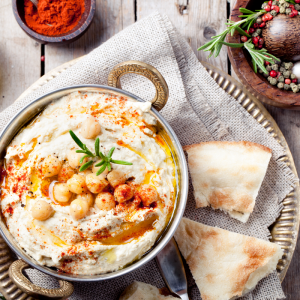 Beans make awesome dips – yummy, garlicky hummus anyone? Or try this simple White Bean Dip with Herbs from Food & Wine magazine. Canned beans are great for dips as they are already mushy (just remember to rinse and drain them thoroughly).
Beans make awesome dips – yummy, garlicky hummus anyone? Or try this simple White Bean Dip with Herbs from Food & Wine magazine. Canned beans are great for dips as they are already mushy (just remember to rinse and drain them thoroughly).- Toss cooked beans into green salads or cast them in a starring role, such as in a beet and lentil salad – you can even used canned beets here too if you wish! Just add some quality olive oil, a squeeze of lemon or splash of red wine vinegar, some toasted walnuts, a bit of goat cheese, serve over a bed of arugula and top with a generous grind of black pepper and you have a gourmet salad with no recipe required.
- Add cooked beans to any soups or stews!
- Purée (rinsed and drained) canned beans and use to thicken soups and sauces.
- Replace half (or all) the meat in burgers, tacos or casseroles (think black bean burritos, lentil shepherd’s pie,, chickpea stew etc.)
- When making short pasta, such as penne, substitute cooked white beans for half the pasta. This will also add flavour and texture to your dish.
- And don’t forget beans for breakfast. This Mexican inspired Black Bean Omelette with Avocado Salsa Verde will wake up your appetite. If you don’t have time to make the salsa verde, just use a quality organic salsa with or without the added avocado. This makes a great weeknight dinner, too, and it couldn’t be simpler!
- You may have thought I was joking about beans for dessert. But try these Black Bean Brownies before you nay-say (or say nay). The wonderful Toronto-made Shockingly Healthy line of brownies and blondies use chickpeas as their base. I always have a four-pack of these on hand (they freeze well) to satisfy a craving at short notice. I serve them often to guests and they never clue in that they are eating chickpeas.
How to avoid tooting your own horn 😉
The full line from the rhyme I started with is this: Beans, beans, they’re good for your heart. The more you eat, the more you fart. But that is not necessarily so. Yes, if you haven’t eaten much in the way of beans and start consuming them in vast quantities you will have consumer’s gas. But if you introduce them gradually you will find that, over time, you will experience less flatulence even as you eat more of them. This is because your body will become used to them and better able to digest the oligosaccharides they contain before the bacteria in your lower intestines do the job for you (and this is what causes the gas).
Until then, here are a few ways to make your bean-related flatus more minimus…
Wind minimizing measures
 Introduce beans into your diet slowly, over several weeks.
Introduce beans into your diet slowly, over several weeks.- Certain beans are more likely to cause issues than others. Lima beans and kidney beans are among the top offenders. Navy beans, lentils and Great Northern beans are more desirable choices in this regard.
- If you are cooking your beans from dried, soaking them in cold water overnight and then discarding and rinsing the beans before cooking them in fresh water will help reduce your gaseous emissions. Cooking beans with a strip of kombu (a type of seaweed) or a pinch of baking soda may also help. As may spices such as cumin, coriander, turmeric and fennel which, at the very least, will make your beans super-tasty.
- If using canned beans, be sure to rinse and drain them thoroughly as the canning liquid has a higher concentration of these oligosaccharides (as well as sodium) than the beans themselves. So make sure you rinse until all the bubbles disappear! And the good news is that canned and rinsed beans have less of these wind-inducing oligosaccharides than soaked, cooked and rinsed dried beans. So it’s another great excuse to opt for the convenience factor of canned beans!
- There are over-the-counter remedies that contain enzymes that help with the breakdown of these oligosaccharides. Beano is one example.
- If all else fails, make sure you have a dog nearby that you can blame… 😉
A more genteel version of the rhyme…
To conclude, I’ve rewritten the rhyme in more genteel fashion and hope I’ve persuaded you to rethink the humble bean. Beans, beans, they’re good for your heart. If you don’t eat beans, I hope you start. The more you eat, the better you’ll feel. So eat some beans most every meal!